Suitability Assessment of Ground-Source Heat Pump System and Its System Optimization Technology
Introductory Video of Shallow Geothermal and Hydrogeology Team
 "Energy-Saving Using Ground Source Heat Energy"
"Energy-Saving Using Ground Source Heat Energy"
Suitability Assessment of a GSHP System and its System Optimization Technology
[ YouTube 3'30 ]
Overview
A Ground-Source Heat Pump (GSHP) system is a technology that originally spread in western countries in the 1980s after the world oil crisis. Although the technology is not new, its use in Japan has been delayed since it was hardly known until around the year 2000. Because the existence of groundwater and its flow rate largely affects the heat exchange rate, it is important to understand the water level and flow rate of groundwater systems in order to effectively utilize GSHP systems in Japan.
Research Target
Shallow Geothermal and Hydrogeology team is conducting research to promote the utilization of Ground Source Heat Pump (GSHP) systems that are highly efficient (higher COP and higher energy saving) compared to general air conditioners and snow melting systems. The team is aiming to develop a high performance and low cost system on the basis of the groundwater flow system and geological characteristics of the area.
There are two types of GSHP system, closed loop system and open-loop system. The closed loop system exchanges heat by circulating heat transfer fluid through high density polyethylene pipes (U tube) buried below the ground. While the open loop system exchanges heat by directly pumping groundwater from sub-surface aquifer (see Figure 1).
Aquifer Thermal Energy Storage (ATES) system is a kind of high efficient open loop systems, in which the exhaust heat from space-cooling is stored into the aquifer during summer, and the heat is extracted during winter by interchanging the pumping and injection wells between the seasons . It is important to understand the groundwater level and velocity because its presence greatly affects the heat exchange rate in both open loop and closed loop systems. The original research on GSHP system considering groundwater is also applicable in Southeast Asia regions for the promotion of GSHP system.
Therefore, the team is engaged in the following tasks to develop the GSHP system suitable for the groundwater and geological characteristics of a site:
- Collection of hydrogeological field data and construction of analysis model for the development of GSHP suitability maps
- Conceptual design and optimization technology of the GSHP system
- Study on the potential application of GSHP system in Southeast Asia
*COP: Coefficient of Performance
【Fig. 1】Types of GSHP system
* In ATES system, extraction and injection wells are exchanged in summer and winter.
* Click to enlarge
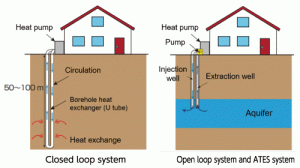
【Fig. 2】Suitability assessment technologies for ground-source heat pump application
* Suitability assessment technologies for ground-source heat pump application
Suitability mapping for ground-source heat pump (GSHP) systems considering the effects of groundwater is a new idea from AIST.
* Click to enlarge
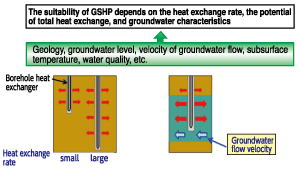
Research Outline
To use a GSHP system, it is important to understand the subsurface hydrogeological conditions of the site. Therefore, we conduct geological surveys by boring, groundwater temperature surveys by depth, regional heat transport simulations with advection effects of groundwater flow, etc. to investigate the suitability of a GSHP system according to the subsurface environment of the area.
The team also conducts studies on the development of GSHP systems suitable for different subsurface conditions. At a GSHP demonstration test site of FREA, the team conducts experiments using two types of heat exchangers: shallow (horizontal) and deep (vertical). The identical system is installed at the Geological Museum of AIST in Tsukuba City, Ibaraki Prefecture to investigate the differences in heat exchange performance and in optimum heat exchange systems in each area having different hydrogeological settings.
The team is mainly engaged in the following research and development themes:
- Research on GSHP suitability assessment
Japan has many regions with abundant groundwater resource at a depth of several meters to a hundred meters. The utilization of a GSHP system would be more efficient if the groundwater flow is considered.
In order to promote the appropriate utilization of GSHP systems, the team conducts research studies in collaboration with Geological Survey of Japan, AIST. The team is also developing methods to assess the suitability of different GSHP systems based on field surveys and numerical analyses.
- Technology development for GSHP systems optimization
The team is evaluating the optimal heat exchange system that can efficiently utilize a shallow (depth: 1‒2 m) or deep (depth: about 100 m or less) heat exchanger and is developing a more efficient heat exchange system based on site-specific hydrogeological conditions. At the GSHP experiment field of FREA and at the Geological Museum of AIST in Tsukuba City, identical GSHP systems combining various types of horizontal and vertical heat exchangers are installed to investigate and evaluate the differences between the two areas, having different hydrogeological settings, in the optimal heat exchange method and their efficiency , by long-term monitoring and numerical simulation. Through the “visualization” of the GSHP systems, with a real-time display of the operating state and observation of the heat exchange borehole, the team aims to promote and diffuse the GSHP system.
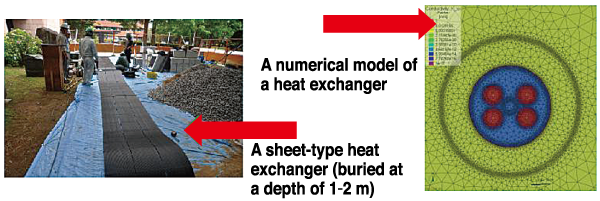
Main Research Facilities
【Fig. 3】FREA Ground-Source Heat Pump System Demonstration Area
This GSHP system uses a sheet-type heat exchanger and a Slinky-type heat exchanger installed at a depth of 1‒2 m and a vertical-type (borehole type) heat exchanger installed at a depth of about 40 m.
【Fig. 4】Ground-source heat pump (GSHP) system installed at Chulalongkorn University, Thailand
Facility at Chulalongkorn University in Thailand used to demonstrate the possibility of cooling operation through the GSHP system in Bangkok.
* GSHP: Ground-Source Heat Pump
Activities and Achievements
1.Development of method to evaluate suitable areas for the open-loop GSHP system.
In NEDO’s research project entitled ‘Development of Renewable Energy on the Heat Utilization Technology’, an evaluation method to determine suitable areas for the installation of open-loop system was developed.
Since the open-loop system directly pumps groundwater, there are some areas where the system installation is difficult due to the condition of aquifer and groundwater flow. In this study, suitable areas for the installation of open loop system and ATES system were evaluated and suitability maps were prepared respectively.
2.GSHP Suitability maps in Tohoku region
In addition to the suitability maps of closed loop system developed for five plains and basins in Tohoku region, suitability maps of open loop and ATES system, that are expected to be promoted in near future, were also developed.
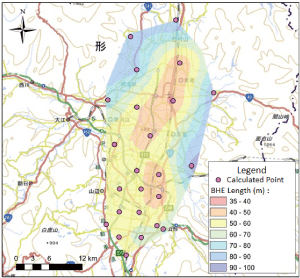 【Fig. 5】GSHP suitability map of closed loop system in the Yamagata Basin; distribution map of required length of borehole heat exchanger (BHE)
【Fig. 5】GSHP suitability map of closed loop system in the Yamagata Basin; distribution map of required length of borehole heat exchanger (BHE)
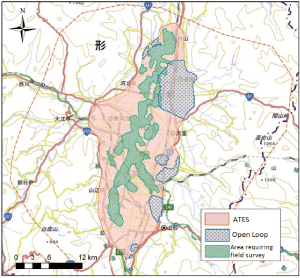 【Fig. 6】GSHP suitability map of open loop system (including ATES system) in the Yamagata Basin
【Fig. 6】GSHP suitability map of open loop system (including ATES system) in the Yamagata Basin
Team Member
| Title |
Name |
| Leader |
TOMIGASHI Akira |
| Senior Researcher |
Shrestha Gaurav |
| Senior Researcher |
ISHIHARA Takeshi |
| Researcher |
SHIMADA Yutaro |
| - |
UCHIDA Youhei |
| - |
MACHIDA Isao |
| - |
YOSHIOKA Mayumi |
| - |
ONO Masahiko |
| - |
JINGUUJI Motoharu |
| - |
ITO Shinobu |
| - |
Arif Widiatmojo |